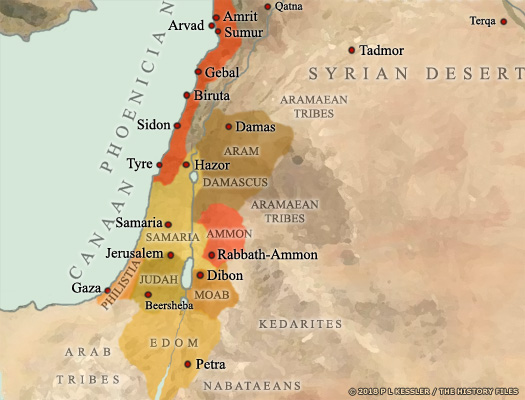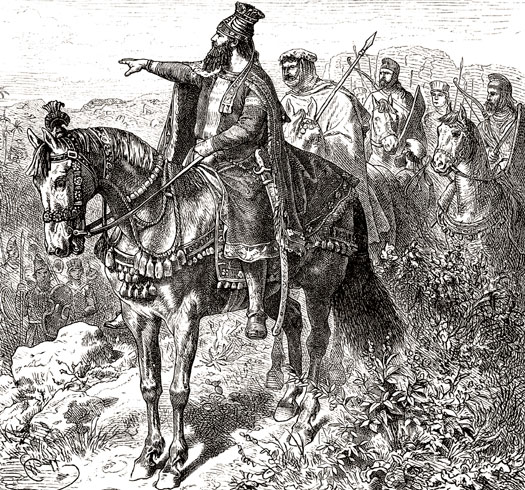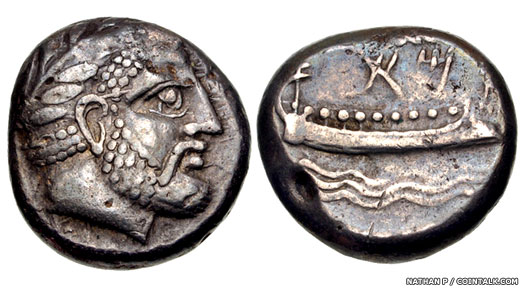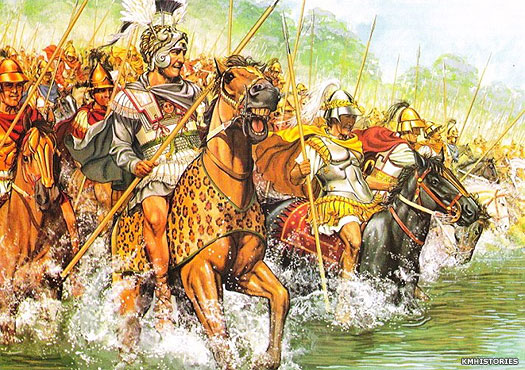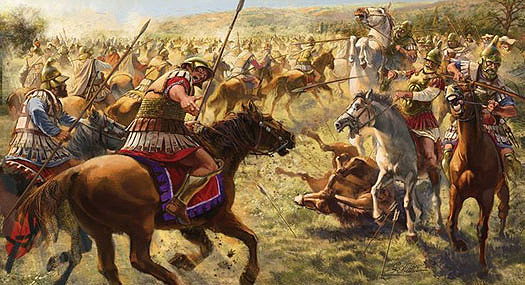
| ARVAD / ARWAD Founded by Amorite settlers at the start of the second millennium BC, Arvad was also populated by Canaanites, and later became a Phoenician kingdom. Known as Arado or Arados to the Greeks, and by many variations thereafter, the fishing town of Arvad fills the only island belonging to modern Syria. It is located three kilometres from Tartus and is approximately 700 metres long. Limited resources meant it was always dependent on the mainland for its survival, but the island was also important as a base for commercial ventures into the Orontes valley. For much of the time, the small city of Amrit fell under Arvad's control, as apparently did a number of regional cities in northern Canaan.
c.1600 BC :
Settlers from Arvad found the city of Amrit, which remains under Arvad's authority.
1472 BC :
Thotmes of Egypt takes Arvad in his campaign in northern Syria.
1453 BC :
The Egyptians conquer the Levant and Syria and establish three provinces in their conquered territories which are named Amurru (in southern Syria), Upe (in the northern Levant), and Canaan (in the southern Levant). Each one is governed by an Egyptian official. Native dynasts are allowed to continue their rule over the small states, but have to provide annual tribute.
c.1200 BC :
There is general collapse in the region as instability grips the Mediterranean coast and the Hittite empire is destroyed by the Sea Peoples and other various groups. Unlike Byblos, Sidon, and Tyre, Arvad is sacked, but the city manages to drive back the invaders and stage a recovery.
Phoenician Arvad :
Descended from the Canaanites who formerly inhabited the entire Levant region, most of these later Canaanites occupied the long coastal strip which forms modern Lebanon. Possibly just a typical Phoenician kingdom, Arvad is thought by some scholars to be the world's first republic, in which its citizens formed the government. Whether they did or not, there are extremely few kings known for this period, and the names of the few that are known only survive through their interaction with the Assyrians.
(Additional information from The Histories, Herodotus (Penguin, 1996), and from External Link: The Role of the Phoenician Kings at the Battle of Salamis (480 BC), Josette Elayi (Journal of the American Oriental Society Vol 126, No 3 (Jul-Sep 2006), pp 411-418, available via JSTOR), and An Updated Chronology of the Reigns of Phoenician Kings during the Persian Period (539-333 BC), Josette Elayi (Trans 32, 2007, available in English at DigitOrient).)
c.1050 BC :
A weakened Egypt loses its remaining imperial possessions in Canaan.
876 BC :
Ashurnasirpal II of Assyria makes Arvad tributary during his conquest of Syria, but the city soon rebels.
fl 853 BC :
Matinu-ba'al / Mattan Baal
853 BC :
Matinu-ba'al is a member of an alliance of states which also includes Ammon, Byblos, Damas, Edom, Egypt, Hamath, Kedar, and Samaria. Together they fight Shalmaneser III of Assyria at the Battle of Qarqar which consists of the largest known number of combatants in a single battle to date, and is the first historical mention of the Arabs from the southern deserts. Despite claims to the contrary, the Assyrians are defeated, since they do not press on to their nearest target, Hamath, and do not resume their attacks on Hamath and Damas for about six years.
When the Neo-Assyrian empire threatened the various city states of southern Syria and Canaan around 853 BC, they united to protect their joint territory - successfully it seems, at least for a time fl 701 BC :
Abd-ilihit / Abdilihit : Became a vassal of Assyria.
701 BC :
Assyria conquers all of Phoenicia. Abd-ilihit is forced to pay tribute to his new masters.
fl 664 BC :
Yakinlu : Vassal of Assyria.
c.664 BC :
Yakinlu is compelled by Ashurbanipal of Assyria to submit and send one of his daughters to become a member of the royal harem, along with a large amount of tribute in the form of a dowry.
fl 650s? BC :
Azibaal / Ozbaal (I) : Vassal of Assyria under Ashurbanipal.
612 - 573 BC :
The Phoenician cities appear to regain their freedom after the destruction of the Assyrian empire.
573 - 539 BC :
Babylonia conquers all of Phoenicia, including Arvad.
539 BC :
Arvad and all of Phoenicia is submerged within the Persian empire. Arvad is one of four 'kingdoms' created by the Persians in Phoenicia, and is ruled by governors in the name of the king.
Persian & Greek Vassal Kings of Arvad / Arados :
Like the other Phoenician cities, at its height Arvad (or Arwad) controlled a number of smaller cities. Unlike Sidon and Tyre, though, these were principally located in Phoenicia itself, such as those of Amrit and Sarepta. In fact, its position as the northernmost of the four greatest Phoenician cities meant that its focus was always a little different, more trading and interacting with northern Syria than establishing Mediterranean colonies. Known as Arado or Arados to the Greeks, and by many variations thereafter, the fishing town of Arvad fills the only island belonging to modern Syria. It is located three kilometres from Tartus and is approximately seven hundred metres long. Limited resources meant that it has always been dependent upon the mainland for its survival, but the island was also important as a base for commercial ventures into the Orontes valley.
Independence ended in 701 BC, following Assyria's invasion and conquest of the Levant in 738 BC. Local arrangements for governance were generally allowed to continue, however, setting a pattern for subsequent domination by Babylonia, Achaemenid Persia, and the Greek empire of Alexander the Great. One of the main reasons for this, especially under the Persians, was that it was the Phoenicians who made up much of the empire's naval forces, both building and manning the ships.
As part of the Achaemenid empire Arvad was one of the four Phoenician vassal 'kingdoms' to be established and controlled by sub-kings in the name of the Persian king (the others being Byblos, Sidon, and Tyre). Overall, Achaemenid-era Phoenicia formed part of a large satrapy which was commanded from Babirush (Babylon) and which included Ebir-nāri (Syria). Later Achaemenid Syria and Phoenicia seem to have been established as a single satrapy in their own right, away from oversight by Babylon. Ebir-nāri dominated this arrangement, with a capital that was probably at Damascus or Sidon. Unfortunately, the task of establishing a chronology for the kings of Arvad during the Persian and Greek periods is even more difficult than it is for the similarly-vague Byblos.
(Information by Peter Kessler, with additional information from The Persian Empire, J M Cook (1983), from The Histories, Herodotus (Penguin, 1996), from The Cambridge Ancient History, John Boardman, N G L Hammond, D M Lewis, & M Ostwald (Eds), from Alexander the Great, Krzysztof Nawotka (Cambridge Scholars Publishing, 2009), from Jewish Antiquities, Flavius Josephus, from Alexander the Great, I Worthington (Routledge, 2004), and from External Links: Encyclopędia Britannica, and the Nabonidus Chronicle, contained within Assyrian and Babylonian Chronicles, A K Grayson (Translation, 1975 & 2000, and now available via Livius in an improved version), and Encyclopaedia Iranica, and Ancient History Encyclopaedia, and The Role of the Phoenician Kings at the Battle of Salamis (480 BC), Josette Elayi (Journal of the American Oriental Society Vol 126, No 3 (Jul-Sep 2006), pp 411-418, available via JSTOR), and An Updated Chronology of the Reigns of Phoenician Kings during the Persian Period (539-333 BC), Josette Elayi (Trans 32, 2007, available in English at DigitOrient).)
539 BC :
Arvad and all of Phoenicia is submerged within the Persian empire. Arvad is one of four 'kingdoms' created by the Persians in Phoenicia, and is ruled by governors (in the form of a retained native monarchy for which documentation is sadly lacking) in the name of the Persian king.
Cyrus the Great freed the Indo-Iranian Parsua people from Median domination to establish a nation that is recognisable to this day, and an empire that provided the basis for the vast territories that were later ruled by Alexander the Great fl 500? BC :
Ozbaal? / Agbalos (II) : Ruled? Vassal of Persia.
fl 480 BC :
Maharbaal / Merbalos : Son. Vassal of Persia.
480 BC :
Invading Greece in 480 BC, the Persians subdue the Macedonians and the Thracian tribes (except for the Satrai, precursors to the Bessoi). Then the vast army of Xerxes makes its way southwards and is swiftly engaged by Athens and Sparta in the Vale of Tempe. The Persian army is held up long enough for the Athenians to prepare their navy for a seaborne engagement with the Persian fleet.
Athens, as the leader of the coalition of city states known as the Delian League, fights the Persian navy at the battles of Artemisium and Salamis, the latter being a resounding Greek victory. Tetramnestus, son of Anysos of Sidon, is present - along with Anysos himself, and other leading Phoenicians such as Mattan of Tyre and Maharbaal of Arvad (Merbalos is the Greek form of his name) - but the battle leaves much of the Persian navy destroyed and Xerxes is forced to retreat to Asia, leaving his army in Greece under Mardonius to face defeat in 479 BC.
Arvad is a little late in starting to mint its own coinage, copying the other three cities of Byblos, Sidon, and Tyre about a generation later than their start date of circa 450 BC. Most Arvadian coins bear the same two letters: 'M' and ☽, when they do not fall off the flan. In some series they are separated by the head of the deity, which can be understood if they represent the abbreviations of two words. Several interpretations have been proposed concerning these two letters, but no consensus has been reached. Perhaps the most logical theory is that it simply says 'king of Arvad', without naming individual kings.
Two sides of an Arvad coin are shown here, dated to between about 420-400 BC which would mark it as being amongst the earliest of the city's issues, complete with two identifying letters on the reverse instead of the three of the fourth century BC The series of coins that is produced between about 400 BC to 333 BC carries a third letter after the other two, with these being proposed as being the initial of the reigning king (alternatives are available such as governors or magistrates, but kings seem most likely seeing as they are certainly in place before and after this phase). The letters are shown below, in no particular order, along with reasonable suggestions of a complete name. An average reign of seven or eight years could be allotted to each king, but of course some reigns would be longer and some shorter.
☽- : Coin inscription.
Y- : Coin inscription.
K- : Coin inscription.
M- : Coin inscription.
N- : Coin inscription.
c.400 BC : S- : Coin inscription.
☾- / Abdashtart? : Coin inscription.
fl 343/342 BC :
P-? : Coin inscription.
339 - 331? BC :
Gerashtart / Gerostratos : Vassal of Persia. Reigned 7 years to 331 BC.
334 - 332 BC : In 334 BC Alexander of Macedon launches his campaign into the Persian empire by crossing the Dardanelles. Much of Anatolia falls by 333 BC and Alexander proceeds into Syria during 333-332 BC to receive the submission of Ebir-nāri, which also gains him Harran, Judah, and Phoenicia (principally Byblos and Sidon, with Tyre holding out until it can be taken by force).
Alexander the Great crossed the River Graneikos (or Granicus) in 334 BC to spark a direct face-off with the Persians that had been brewing for generations, and his victory in battle near the river sent shockwaves through the Persian empire Gerostratos of Arvad (or Arados to the Greeks) is only too ready to ally himself to Alexander the Great, even supplying ships to aid in the conquering of Tyre. His son, Strato, personally welcomes Alexander, but it is unknown whether he reigns now, later, or at all, and whether Gerashtart remains on the throne. ? BC :
Abdashtart / Strato / Straton : Son. Reigned?
329? BC :
The cities of Arados, Byblos, Sidon, and Tyre are incorporated into the satrapy of Syria within the Greek empire. The satrap in Syria is probably Menes (probably the son of Dionysius who had been raised to the circle of Alexander's 'Bodyguards' in 333 BC - a major distinction which would mark him out as a commanding figure), although his role has been called into question by some scholars.
323 - 320 BC :
Immediately following Alexander's untimely death, Syria and Phoenicia are assigned to Laomedon. He is confirmed in his position during the second partition of Alexander's empire in 321 BC in the middle of the First War of the Diadochi, while Cilicia has been separated as a satrapy in its own right. But Ptolemy of Egypt soon begins taking an interest, offering him a large bribe to hand over his satrapy. When Laomedon declines his offer, Ptolemy sends an army under the command of Nicanor to take it by force by 318 BC.
Laomedon has little with which to resist so he is taken prisoner, escapes, and seemingly joins the general opposition to the Antigonids. His final fate is unknown while Antigonus governs Syria (and Phoenicia) during the period of the remaining Wars of the Diadochi.
313 - 301 BC :
The domination of Syria and Phoenicia by Ptolemy of Egypt briefly comes to an end in 313 BC when he joins the widespread opposition to the Antigonids. In 312 BC Seleucus Nicator defeats Demetrius, son of Antigonus, at the Battle of Gaza which briefly allows Ptolemy to reoccupy Coele Syria. Following a reversal in battle fortunes he pulls out again as Antigonus invades Syria in strength to occupy it.
The Battle of Ipsus in 301 BC ended the drawn-out and destructive Wars of the Diadochi which decided how Alexander's empire would be divided 301 - 63 BC :
Much of Syria and Phoenicia are gained by the Hellenic Seleucid empire following the decisive Battle of Ipsus in 301 BC, although Seleucus allows Ptolemy to retain Coele Syria. Seleucus had already declared himself king of Syria and Babylonia in 305 BC, immediately founding the city of Seleucia in Mesopotamia by massively rebuilding and expanding an existing settlement.
Arvad is later renamed Antiochia in Pieria by Seleucid king, Antiochus I Soter. Over the years, the Seleucids go to war against Ptolemaic Egypt over the rest of Syria, with full possession finally being gained at the end of the Fifth Syrian War in 195 BC. With the final fall of the Seleucids in 63 BC, Phoenicia is taken by Rome.
Source :
https://www.historyfiles.co.uk/ |
